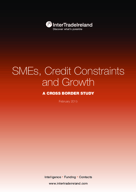SME's, Credit Constraints and Growth - A Cross-Border Study
Published: February 2015
Executive Summary
Ensuring that firms have access to the financing options appropriate to them and that they are not constrained by funding limitations from undertaking positive investment projects is an important ingredient in supporting economic recovery and growth. This is particularly important for Small and Medium Enterprises (SMEs), given that they have generally been shown to have less diversified financial structures and tend to be more exposed to negative economic and financial shocks than our larger firms.
This report uses detailed survey data collected by InterTradeIreland to examine the financing structures and obstacles of firms across the island of Ireland. We focus specifically on how financing has developed between 2012 and 2014 as these economies have moved back into growth. The research presented here covers a broad spectrum of issues related to the funding of the SME sector, beginning by looking at the types of finance most commonly used, the demand for finance, examining the extent to which firms are subject to credit constraints, if these constraints affect their overall performance, and how widespread financial distress is amongst firms. Finally, the report examines if the banking system North and South of the border impacts on these issues, looking in particular at the question of whether banks operate different strategies outside of their core domestic market.
KEY FINDINGS:
- Most firms use short-term sources of finance: the most common product used is an overdraft facility, which is used by approximately 40 per cent of firms. The percentage of firms using commercial loans was 22 per cent in 2012 but reduced to 17 per cent in 2014.
- Larger and more established firms are more likely to use all of the different finance types, with smaller and younger firms having access to a less diversified set of products.
- Application rates for credit fell between 2012 and 2014.
- The percentage of firms identified as credit constrained fell by half between 2012 and 2014.
- There is no statistically significant evidence of differences in the incidence of credit constraints across countries but Northern Irish firms are less likely to experience financial distress.
- Smaller and younger firms remain more likely to be credit constrained.
- With the decline in the levels of credit constraints, there is no evidence of this type of constraint having a negative effect on firm performance.
- The percentage of firms reporting no experience of financial distress increased from 40 per cent in 2012 to 63 per cent in 2014.
- Property debt overhang continues to be a problem for some firms.
- There is no evidence of different behaviour by banks operating cross-border.
Click here to download the full report: SME's, Credit Constraints and Growth - A Cross-Border Study

